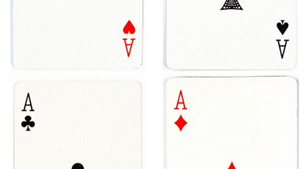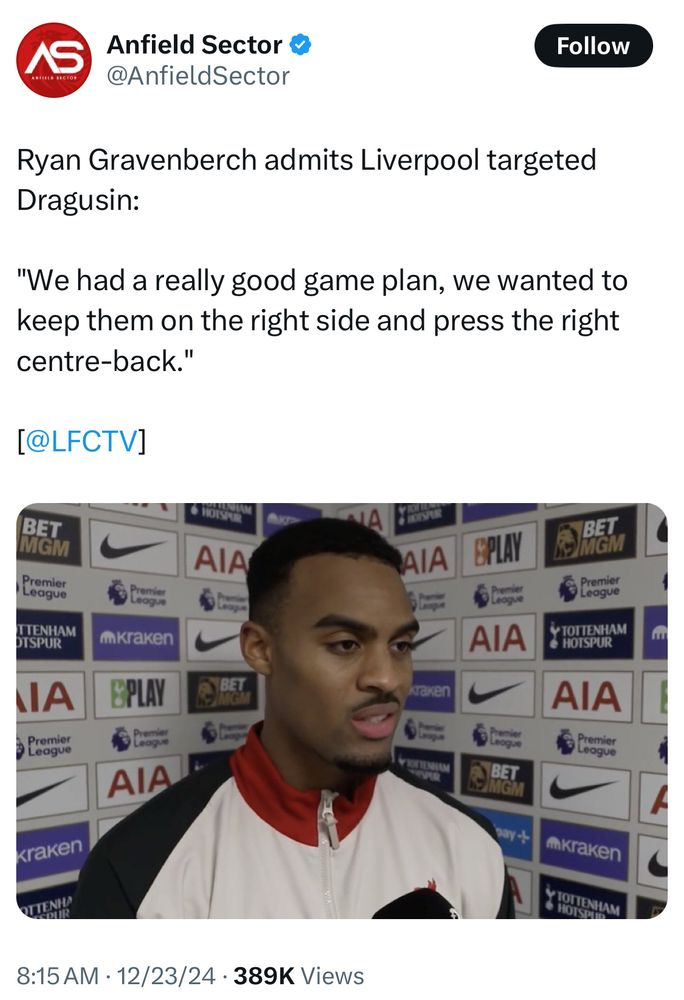How Ange's Spurs Outmaneuvered Slot's Liverpool
Ange won the tactical battle with a card up his sleeve.
You can learn a lot about a football commentator by observing when and for whom they put outcomes down to tactics versus other causes, such as injuries, fatigue, ‘form,’ or just the luck of the bounce.
When it comes to Ange Postecoglou, commentators are reluctant to attribute any positive outcomes to his tactical setup or adjustments, reserving all tactics conversations—such as they are—for explaining Spurs’ defeats or shortcomings. In other words, when we win, it’s because ‘Liverpool were poor’ or ‘City’s side were heavily rotated,’ but when we lose, it’s because ‘Ange is out of his depth’ or ‘naive tactics.’
Part of this development is down to Ange himself, whom I’ve noticed prefers not to get into the tactical weeds during press conferences, as some managers do. I think people too easily mistake his preferences for press conference topics for a lack of tactical insight or acumen.
Manchester United only had to push Liverpool to a draw for United boss Ruben Amorim to get his tactical flowers, whereas when Ange’s Spurs held Liverpool to a clean sheet in a cup semifinal, taking a 1-0 victory with a goalkeeper who’d only just arrived at Tottenham over the weekend, with two 18 year olds in the team, one of whom is playing out of position, and with a slew of injuries and suspensions beyond that (including James Maddison, who’s Premier League goal contributions are second only to Cole Palmer’s among midfielders), commentators continued to ponder, like a group of dogs puzzled by a fifth round of three card monte, whether Ange has in fact made tactical tweaks to achieve the unexpected result.
Tactical Adjustments: The Long Pass
Now, I’ve been tracking one facet of Spurs’ tactical change all season—the number of long passes they attempt—in an effort to understand whether and how Ange responds tactically to the heavy injuries we’ve sustained to the goalkeeper and back line as well as the front line, two areas where Spurs are not as deep as they are in the midfield positions.
As you know by now, two things in particular are key to Ange’s tactics: (1) an aggressive high press aimed at converting high turnovers into chances, forcing opponents deeper into their half of the pitch, and giving opposing defenders and deep midfielders little time on the ball to find a progressive pass; and (2) rapid and dynamic build-up out of the back to pull opponents out of position and launch attacks from virtually any depth on the pitch.
Of course, to execute the high press, you need physically capable players and fresh legs to come in and relieve a hardworking front line, and you don’t have that when you only have 3 or 4 senior players available to play across all 3 front-line positions.
Similarly, Spurs’ buildup relies on a combination of composure on the ball, progressive passing under pressure, and progressive carrying under pressure, without which we can be vulnerable to the opposition press and concede turnovers in dangerous areas. Spurs’ back line achieve this through a range of player profiles and abilities: Vicario is calm on the ball and a good short, quick passer under pressure. Romero is one of the best back-line progressive passers in the league. van de Ven and Udogie are both physically commanding and excellent at carrying the ball out of pressure, using their strength and physicality to shield the ball and gliding past opponents with powerful strides. Finally, Bissouma and Maddison, though in different ways, provide secure outlets or pressure valves for the back line to break the press, dropping deep and receiving comfortably on the turn.
Spurs can afford to lose 1 or2, maybe 3 of these players and profiles and still impose themselves in buildup, but can’t afford to lose 4, 5, or 6. Just like against Chelsea last season, from around match week 10 this season, Spurs have been playing under such conditions: short in the front line, weakening the press, and short in the back line, hampering the buildup. I’ve sketched out the numbers that demonstrate the impact of our injuries in these ways here, showing the dramatic difference in our underlying numbers before and after the major injuries set in.
Accordingly, Ange has made clear tactical adjustments, one dimension of which is, as I’ve suggested, solving the buildup problem by playing long more often:
As you can see, especially against high-pressing opponents such as Newcastle and Liverpool, but also against the adept pressing plans of Glassner and Palace and McKenna and Ipswich, Spurs have increasingly opted for the long pass.
You get a better picture of this by viewing Spurs’ long passing in the form of a timeline. As you can see below, up until Spurs ran into injury problems that significantly hampered buildup—mainly the loss of Romero, van de Ven, and Vicario—what was initially a steady rate of long passes attempted started to become volatile as Ange and the squad reacted to different degrees of opposition pressing and squad depletion:
Of particular note here is that all of Spurs’ instances of unusually high pass volume (> 38 long passes in a game, or more than standard deviation from the mean) have come after the injury crisis set in (mean: 31.85; standard deviation: 6.5).
A Closer Look at How Ange Handled Liverpool
Indeed, in the league cup semi-final against Liverpool, Spurs played 49 long passes, more than they have in any other match this season. Though one very good post-match analysis does well to show that Ange really did make tactical adjustments against Liverpool, the author, Ali Tweedale, frames this as ‘like nothing else we have seen before in the Ange Postecoglou era.’
But as I’ve shown above, we’ve seen this quite a lot lately from Ange’s Spurs. So what was different this time?
For one, it’s important to point out that some of Spurs’ injury-induced buildup problems have been partially relieved by the emergence of Archie Gray, Lucas Bergvall, and Djed Spence. Gray has proven both a calm carrier of the ball out of the back in buildup and a good progressive passer, making up for some of what’s lost when Romero and van de Ven aren’t on the pitch.
Similarly, Bergvall has shown himself rather fearless in dropping deep—like Bissouma and Maddison do—to collect the ball, turn, and progress it. Spence, meanwhile, has shown he can carry the ball out of trouble, like Udogie and van de Ven, as well as combine in tight spaces perhaps better than those two.
All of this together hasn’t entirely made up for the significant injury losses, but it has helped Spurs build from the back and progress the ball through the midfield into good attacking scenarios much better than they had been while these less experienced players were still getting up to speed.
But perhaps more importantly, Ange’s decision to play new goalkeeper Antonin Kinsky turned out to be a deciding factor in the victory.
Especially because Brandon Austin played well in his Spurs debut, the choice to essentially pluck 21 year old Kinsky off the plane and chuck him in goal against the the top team in Europe in a cup semi-final took some fortitude. But I don’t think Ange was just going with the bold option for the sake of boldness; I think there was real tactical intent behind this decision.
To grasp Ange’s tactical intent, we have to understand something of Arne Slot’s game plan. Ryan Gravenberch revealed a telling component of it in a post-game interview:
We’ve had a strong sense for a while that opponents were targeting Spurs’ right side with the press, especially Dragusin, who’s an excellent defender but not great on the ball. Without Romero on the right side, Porro has a lot more work to do in buildup, as well as in getting forward and back and forward and back, so targeting Dragusin not only puts pressure on Spurs’ weakest player in buildup, but also, to some extent, neutralizes Porro’s attacking threat by pulling him back to give Dragusin an outlet.
The introduction of Kinsky in effect neutralized Slot’s plan to pressure Spurs’ right side, and it’s something Ange saw going into the match that Slot didn’t. Ange knows by now that opponents will target Dragusin in buildup; the question has been how to deal with that problem.
Going long only works to an extent; if it’s too predictable (your only option under pressure) or too sloppy (your long passing isn’t very accurate), you’re just turning the ball over to your opponent and inviting pressure. But if you have a goalkeeper like Kinsky—who showed from the beginning that he was comfortable with the ball at his feet and in making a full range of short and long passes—then you open up more dynamic buildup opportunities.
So, Kinsky is not only able to play more accurate medium and long passes across the pitch than Forster or Austin, he’s also able to move off the ball around the penalty area and provide passing angles of relief for Dragusin and other defenders, offering a trustworthy option for short passing and field-switching in buildup. Kinsky attempted 45 passes against Liverpool, completing 71%, including 6 / 19 long passes. By contrast, against Wolves, Forster completed 62% of less than half the number of attempts (21), while Austin completed 67% of 27 total passes against Newcastle.
Again, Ange recognized this component of Kinsky’s game, and Slot didn’t see it coming. Liverpool start off trying to execute their plan, pressing high, especially on the right side, but Kinsky made himself available to take pressure off Dragusin, allowing Porro to get forward or free to play in Solanke in moves like the one that led to the match-winner. Once Liverpool recognized that Kinsky allowed Spurs to neutralize their press, they backed off, again leaving space for the likes of Porro, Gray, and Spence to progress the ball.
In the end, Ange was comfortable enough letting Liverpool have the majority of possession without letting them control the game (notably, Spurs had the majority of possession in the recent 3-6 league loss to Liverpool, so this was another adjustment). Spurs were able to make this tactical adjustment because they could bypass the midfield gap between the back line and the front line, sitting a little deeper and more compact to address Liverpool’s league-leading attack while still carrying goal threat and the ability to build out from the back.
Credit goes to the players—especially the less experienced players who’ve stepped up their performance levels after a run of games in the team, and the excellent Dom Solanke for tracking down those long passes and keeping the ball for Spurs—but also to Ange Postecoglou for anticipating how Slot and Liverpool would approach the game and making a bold call with Kinsky that he knew would open up solutions.










Like a Kane penalty- Prof don't miss!!
The prof don’t miss!